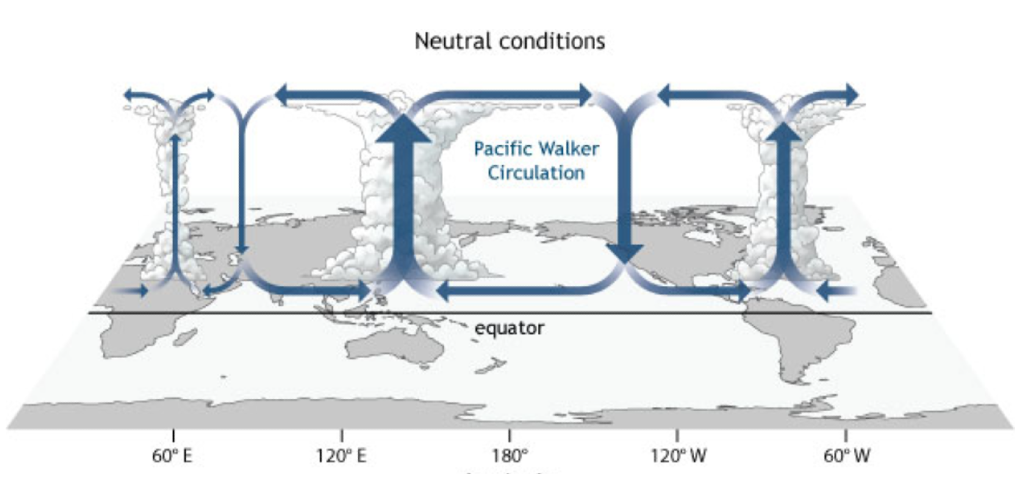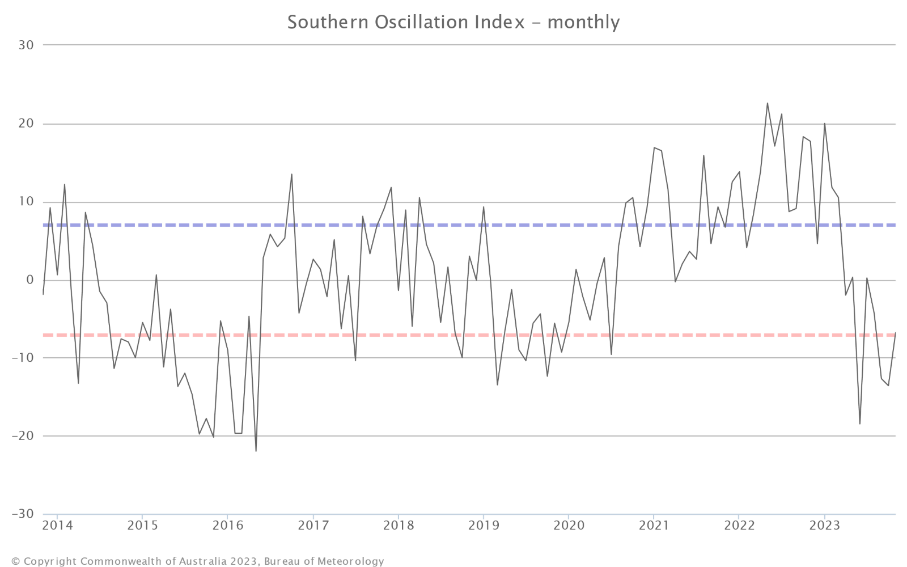Insights November 2023

Insights November 2023
The section also explores the basics of carbon credits and the benefits that these credits can have for farming businesses.
Climate
Climate, it is said, is what you hope for; weather is what you get.
A set of complex interactions impact the Australian climate. We introduce this topic to provide climate data and commentary to help you interpret that data. With that perspective, you may be better placed to anticipate and adapt to changes as they come along.
It is helpful to have a good understanding of some fundamentals of climate, to place seasonal weather in context.
The starting point is to visualise the Australian climate is the Walker Circulation. It is an atmospheric loop centred over the tropical zone of the Pacific. Air in the lower part of the loop flows from east to west. In its neutral phase, air rises over warm water in the western Pacific. It then flows back in the upper atmosphere towards the eastern Pacific. It descends over the cooler water there, and cycles again. When influences push it away from neutral, different circulations are set up. The result is an El Nino or a La Nina phase.

There are atmospheric circulation cells next to the Walker Circulation. The circulation over the Indian Ocean has an influence on the climate of countries surrounding it. This circulation is a significant contributor to the variability of rainfall in this region. On the left side of the main Pacific Walker circulation cell is a similar cell over the Indian Ocean.
Indian Ocean Dipole (IOD) is used to indicate the status of the Indian Ocean loop. It measures the difference between sea surface temperatures in the Arabian Sea and a location south of Indonesia. Currently the IOD is in a positive phase. This leads to reduced spring rainfall for central and south-east Australia. When a positive IOD and El Niño occur together, their drying effect is often stronger and more widespread across Australia. This is the case right now. Predictions are for it to continue beyond December.
The Southern Oscillation Index (SOI) is the measure used to assess the status of the Pacific Walker Circulation. The SOI measures the difference in surface air pressure between Tahiti and Darwin. It is one of the key atmospheric indices for gauging the strength of El Niño and La Niña events. It provides guidance about potential impacts on the Australian region. Sustained negative values below about –8 indicates an El Niño.

The Southern Annular Mode (SAM) refers to the belt of winds in the region south of Australia down towards the South Pole. This belt of winds drifts north towards the Great Australian Bight and back south towards the Pole, over a timeframe ranging from a week to months. The SAM also has its neutral, positive, and negative phases. In future editions we will talk more about the regional and seasonal implications of this climate driver.
The Madden-Julian Oscillation (MJO) is another climate feature which has impacts on the prevailing El Niño or La Nina phase. The MJO is a pulse of clouds, rainfall, wind, and air pressure. It moves in an easterly direction around the Earth in the tropical zone every thirty to sixty days. It is currently weak but is expected to strengthen. Though where the pulse will emerge this time is not clear.
In future editions we will talk more about the regional and seasonal implications of the climate drivers, as they are influencing current and future weather. Next month we will have a look at the Pacific Walker Circulation in its El Niño phase and how the other climate influences seem to be interacting with it.
Carbon
Carbon credits are widely discussed in farming communities. Many farm businesses will have considered the opportunity. Some will have projects up and running. Some will have been approached directly by a carbon aggregator. A carbon aggregator is a private company which provides services to develop and operate carbon sequestration projects. In this edition, we talk about some of the fundamentals to help farms make an informed decision. In coming editions, we will explore the process of establishing a carbon farming project.
What exactly is an ACCU?
An Australian Carbon Credit Unit (ACCU) is a financial instrument like a share. ACCUs are a financial product under the Corporations Act 2001.
Each ACCU represents one tonne of carbon dioxide equivalent (tCO2-e) emissions stored or emissions avoided by a project registered in Australia with the Clean Energy Regulator (CER).
How Could my Business Benefit from Carbon Credits?
ACCUs can be sold to generate income, either to the Australian Government through a carbon abatement contract, or to companies and other private buyers in the secondary market.
They are potentially a source of funds:
- to modify farm activities;
- to implement new management techniques that sequester carbon and improve productivity. These strategies can improve farm resilience;
- to adapt to climate change;
- to implement changes to reduce your greenhouse gas emissions profile; and
- to reduce loan obligations. This is best left to after year ten of the project. By then the amount of ACCUs being sequestered every year will be clearer.
A farm’s decision on what to do with carbon credits is an important strategic one. Selling carbon credits to government or to another business means the ACCUs are used as offsets. Big emitters of greenhouse gases are required to stay below a cap. Any excess emissions must be offset by purchasing ACCUs on the market. These ACCUs are then retired. They can only be used once.
The other choice is to save the ACCUs for ‘insetting’ against your farm’s emissions. The Taskforce on Climate-related Financial Disclosure (TCFD) is an international agreement among financial institutions to play a role in reducing greenhouse gas (GHG) emissions. It is progressively being implemented around the world. Financial institutions and their larger clients are being asked to provide information on their emissions profile including what is known as Scope 3 emissions i.e. suppliers and customers. There is an expectation that every business will progressively reduce emissions.
A farm might choose to assess their emissions and start on their decarbonisation journey before selling ACCUs. It will take time and resources to implement the necessary changes to address some emissions sources. Once a farm’s emissions reduction plans are well advanced, it may seem appropriate and attractive to sell some ACCUs.
The process of applying for approval of a carbon farming project is slow moving and has costs associated with it. It may take six months or more to complete the application.
There may be capital costs to change your farming methods and impacts on cash flow for more than five years.
It is important to consider whether to make the application yourself or work with a carbon aggregator. It is prudent to seek specialist advice on the financial, taxation and other aspects of a carbon farming project. Whether it is a contract directly with the CER or with a carbon aggregator, it is essential to understand the nature of the commitments the farm is undertaking. We will talk more about that in coming editions of this newsletter.
If you are considering a project now, you might want to wait for the declaration of the new Integrated Farm Method expected in early February 2024. It will enable farms to run two projects on the same piece of land. The way to envisage it is as a soil project under the ground and a vegetation project on the surface. We will provide more details when the new Method is announced.
Most Popular
Subscribe to insights today
Receive reports direct to your email by subscribing to Rural Bank Insights.

